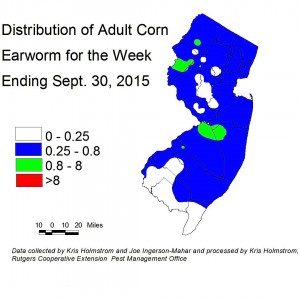Sweet Corn
European corn borer (ECB) adults were nearly nonexistent this past week. No map image will be produced. There should be little, if any, remaining impact from ECB this season.
Corn earworm moth (CEW) activity declined over the previous week, with low temperatures prevailing (see CEW Map). The current warmer, disturbed weather pattern and tropical storm forecast to hit our area within the next week may result in increased activity. At current levels, CEW remains a significant threat to silking sweet corn plantings.
| The highest nightly CEW blacklight trap catches for the previous week are as follows: | ||
| Crosswicks 2 | Georgetown 1 | Pedricktown 1 |
| Belvidere 1 | Milltown 1 | Sergeantsville 1 |
| Chester 1 | New Egypt 1 | Springdale 1 |
| East Vineland 1 | Newton 1 | Tabernacle 1 |
The blue areas in the blacklight map indicate a 4 day schedule, with green areas indicating a 3 day schedule. In general, 4-day schedules are warranted throughout southern NJ at this time.
[The CEW pheromone trap network in southern NJ has been reduced to just a few sites, making a map image unreliable.]
| The highest nightly CEW pheromone trap catches for the previous week are as follows: | ||
| Woodstown 6 | Springdale 2 | |
| Green Creek 5 | Eldora 1 | |
For silking sweet corn, the following spray schedules are warranted.
Silking Spray Schedules*:
South – 4 days
Central – 4 days
North – 4-5 days
Fall army worm (FAW) activity is lower, but still a problem for late season corn. Growers of transgenic (B.t.) corn are now seeing signs of FAW infestation in harvested ears. Under this type of pressure, growers should consider a 5-7 day spray schedule on transgenic sweet corn through the silk period.
FAW do not respond well to pyrethroid insecticides. The most useful products are those in the IRAC group 28 class (Coragen, Exirel, Belt) or the IRAC group 5 class (Radiant, Entrust), or combination products including these classes. See the 2015 Commercial Vegetable Recommendations Guide for insecticides effective against FAW.
Hawaiian Beet Webworm
Hawaiian beet webworm (HBWW) adults are still present in blacklight traps in Atlantic, Burlington, Camden and Gloucester counties and are active through Monmouth, Middlesex and Mercer counties. There have been no reports of significant infestations, but target crops should be checked regularly.
This pest favors beet greens, Swiss chard and spinach. Damage occurs directly on leaves, with larvae spinning protective webbing on the underside of leaves. Heavy moth populations may be found in dense stands of galinsoga.
Cole Crops
Crucifer downy mildew (CrDM) is now active in some plantings throughout the state. Broccoli and collard greens are especially susceptible to this disease. Signs include sharp yellow spots on the upper surface of older leaves and whitish sporulation on the lower leaf surface. It is best to treat preventively for this disease, as it can be very destructive if not detected quickly and subject to appropriate fungicides. See the 2015 Commercial Vegetable Recommendations Guide for fungicides effective against CrDM.
Imported cabbageworms are the primary caterpillar pest of cole crops at this time. Be sure to check the youngest foliage on plants, as the larvae prefer to feed on this tissue. Consider treating if caterpillars are found on 10% or more plants that are in the 0-9 true leaf stage. From 9-leaf to the early head stage (in broccoli, cauliflower and cabbage) infestations up to 20% may be tolerated. Once heads begin to form, a 5% threshold should be observed to protect the marketable portion of the plant. For leafy greens such as collards and kale, 10% plants infested is the threshold throughout.


